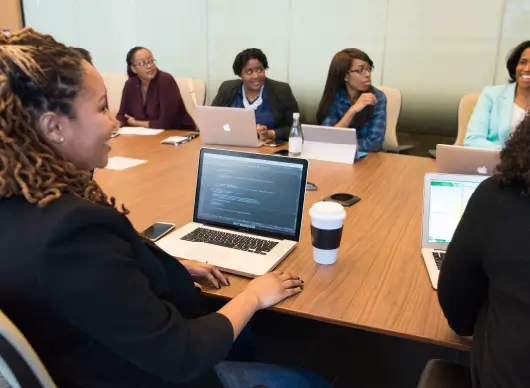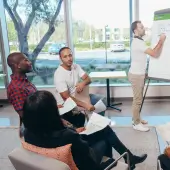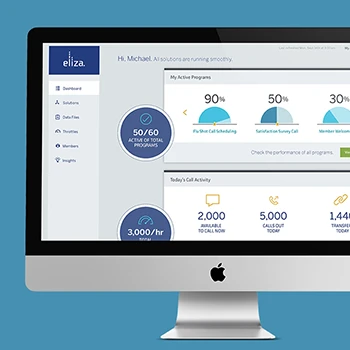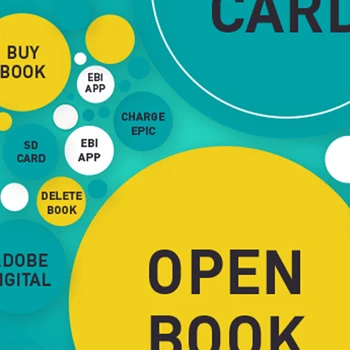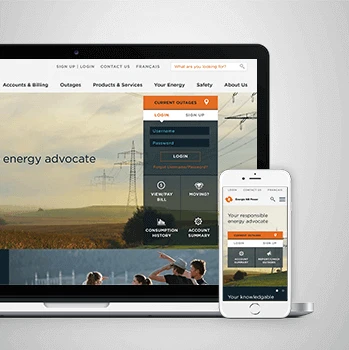What exactly is digital team growth and why do UX organizations need it?
Digital team growth focuses on developing Experience Thinking capabilities across research, design, brand, content, product, and service experiences. Modern UX teams must embrace continuous learning to stay relevant as user expectations evolve, technologies advance, and business models change. Growth programs ensure teams deliver exceptional experiences through ongoing capability development rather than static skill sets.
Tip: Assess your team's current experience thinking maturity across all four Experience Thinking quadrants rather than just design skills to identify the most impactful growth opportunities.
How does digital team growth differ from traditional UX training programs?
Traditional training often focuses on individual skills or tools, while digital team growth develops holistic Experience Thinking capabilities that connect brand, content, product, and service experiences. The approach emphasizes real-world application, peer learning, and organizational culture development rather than just knowledge transfer. Growth programs build sustained learning mindsets rather than one-time skill acquisition.
Tip: Choose growth programs that include practical application opportunities and peer collaboration rather than just theoretical knowledge delivery.
What learning outcomes should we expect from a digital team growth program?
Teams develop strategic thinking capabilities, advanced research and design skills, cross-functional collaboration abilities, and experience architecture understanding. Participants gain confidence applying Experience Thinking frameworks to real organizational challenges. The program builds capabilities in user research, journey mapping, interaction design, information architecture, and persuasive design while connecting all areas to business outcomes.
Tip: Define specific capability development goals aligned with your organization's strategic objectives rather than just general skill improvement expectations.
Who should participate in digital team growth programs?
Programs benefit UX researchers, designers, product managers, business analysts, and anyone involved in experience creation. Participants range from beginners building foundational understanding to experienced professionals seeking strategic advancement. Mixed experience levels create rich peer learning opportunities that accelerate capability development across the entire organization.
Tip: Include cross-functional participants beyond just UX roles to build shared experience thinking language and collaboration capabilities across your organization.
What foundational knowledge do participants need before starting?
Most programs assume limited prior UX knowledge and build from foundational concepts. Participants benefit from curiosity about user-centered design, willingness to engage in collaborative learning, and commitment to applying new concepts in their work. The Experience Thinking approach accommodates different starting points while building comprehensive capabilities.
Tip: Survey participants about their current experience levels and learning preferences to customize the program approach and maximize engagement effectiveness.
How does the Experience Thinking framework guide team growth?
Experience Thinking provides a holistic learning framework that connects brand, content, product, and service experiences rather than treating them as separate disciplines. Teams learn to orchestrate experiences across all touchpoints while understanding how each area contributes to overall user value. The framework guides capability development in strategic, integrated ways rather than isolated skill building.
Tip: Map your current team capabilities against all four Experience Thinking quadrants to identify strategic development priorities rather than focusing only on obvious skill gaps.
What role does peer learning play in digital team growth?
Peer learning accelerates capability development through shared problem-solving, diverse perspective integration, and collaborative skill building. Participants learn from each other's experiences while building networks that support continued growth. The approach creates learning communities that sustain development beyond formal program completion.
Tip: Encourage peer mentoring relationships and knowledge sharing practices that continue after formal training to maximize long-term learning impact.
What certification options are available through digital team growth programs?
Programs offer User Experience Designer and User Experience Researcher certifications through structured five-course pathways. Each certification requires completion of all courses within two years, ensuring comprehensive capability development. Certifications validate expertise in Experience Thinking principles, research methods, design processes, and practical application skills.
Tip: Choose certification pathways that align with individual career goals and organizational capability needs rather than just selecting based on current role titles.
How do UX Designer and UX Researcher certification paths differ?
Designer certification emphasizes interaction design, information architecture, and persuasive design alongside foundational UX principles and research skills. Researcher certification focuses on advanced research methods, journey mapping, and usability testing while including foundational design understanding. Both paths integrate Experience Thinking frameworks and practical application throughout.
Tip: Consider having individuals pursue both certifications over time to build comprehensive Experience Thinking capabilities rather than limiting development to single specializations.
What time commitment is required for certification completion?
Each certification requires five full-day courses that can be completed in week-long intensive sessions or spread over time based on individual and organizational preferences. Participants have two years to complete all courses, allowing flexibility for work scheduling and learning pace preferences. The structure balances intensive learning with practical application opportunities.
Tip: Plan certification schedules that allow time for practical application between courses rather than completing all training in rapid succession without real-world practice.
How do certifications align with career advancement opportunities?
Certifications validate Experience Thinking capabilities that organizations increasingly seek for strategic UX roles. The comprehensive curriculum develops both tactical skills and strategic thinking abilities that prepare professionals for leadership positions. Certified professionals demonstrate commitment to continuous learning and holistic experience design understanding.
Tip: Connect certification completion to specific career advancement opportunities and increased responsibilities rather than treating certification as an end goal in itself.
What ongoing support is available after certification completion?
Certified professionals join a community of Experience Thinkers with access to ongoing learning resources, networking opportunities, and advanced development programs. The community provides continued support for applying Experience Thinking principles in evolving organizational contexts. Advanced programs help certified professionals stay current with emerging methodologies and industry trends.
Tip: Leverage the certified professional community for ongoing mentoring, collaboration opportunities, and continued capability development rather than treating certification as completion of learning.
How do we measure the value of certification investments?
Value measurement includes capability assessments, project outcome improvements, career advancement tracking, and organizational experience quality metrics. Certified professionals typically demonstrate improved problem-solving abilities, stronger stakeholder collaboration, and more strategic approach to experience challenges. The investment creates sustained competitive advantages through enhanced team capabilities.
Tip: Establish baseline capability measurements before certification begins and track both individual development and organizational impact to demonstrate investment return.
Can certification requirements be customized for our organization?
While standard certification paths ensure comprehensive capability development, custom training components can address specific organizational contexts and challenges. Custom elements complement core certification requirements rather than replacing them. The approach maintains certification integrity while addressing unique organizational needs and priorities.
Tip: Identify specific organizational challenges that custom training elements should address while maintaining commitment to comprehensive Experience Thinking capability development.
What delivery options are available for digital team growth programs?
Programs offer in-person, live online, and self-paced delivery options to accommodate different learning preferences and organizational constraints. In-person sessions provide intensive collaboration experiences, while virtual options offer flexibility for distributed teams. Self-paced courses allow individual scheduling while maintaining comprehensive curriculum coverage.
Tip: Mix delivery methods based on learning objectives and team preferences rather than selecting single approaches to maximize engagement and effectiveness.
How do in-person and virtual learning experiences compare?
In-person sessions excel at collaborative activities, peer networking, and intensive focus development. Virtual sessions provide flexibility, broader accessibility, and effective knowledge transfer through interactive online platforms. Both formats maintain hands-on learning approaches and practical application emphasis. The choice depends on organizational context and learning objectives.
Tip: Consider hybrid approaches that combine in-person intensive sessions with virtual follow-up and ongoing support to leverage the benefits of both delivery methods.
What technology and materials are required for different delivery methods?
In-person sessions provide printed course materials and don't require laptops for most courses. Virtual and self-paced options use learning management systems with digital resources and interactive capabilities. All formats include comprehensive course materials, templates, and reference resources for ongoing application.
Tip: Ensure participants have reliable technology access and technical support for virtual sessions rather than assuming all individuals have optimal learning environments.
How do self-paced options maintain learning quality and engagement?
Self-paced courses use interactive learning management systems with structured modules, practical exercises, and progress tracking capabilities. While offering scheduling flexibility, they maintain comprehensive curriculum coverage and application opportunities. The format works well for motivated learners who prefer individual pacing over group dynamics.
Tip: Provide coaching support and peer connection opportunities for self-paced learners to maintain engagement and address questions rather than expecting completely independent learning.
What support is available during virtual learning sessions?
Virtual sessions include dedicated technical support, interactive platform features, breakout room collaboration, and instructor guidance throughout. Participants receive comprehensive onboarding for virtual platforms and ongoing assistance with technical challenges. The approach maintains learning quality while addressing virtual delivery complexities.
Tip: Conduct technology rehearsals before virtual sessions begin and provide multiple communication channels for support to ensure smooth learning experiences.
How do different delivery methods accommodate global or distributed teams?
Virtual and self-paced options effectively serve global teams across time zones while maintaining curriculum integrity and collaborative learning opportunities. Programs can be scheduled to accommodate different regions and provide asynchronous collaboration tools for continued engagement. The approach enables organizational learning regardless of geographic distribution.
Tip: Plan delivery schedules that rotate time zone accommodations fairly and provide recorded content for asynchronous access to ensure equitable participation opportunities.
What factors should guide our delivery method selection?
Selection factors include team geographic distribution, learning preferences, available time blocks, collaboration objectives, and organizational culture. In-person works well for intensive capability building and team bonding. Virtual offers flexibility and broader access. Self-paced accommodates diverse schedules while requiring higher individual motivation.
Tip: Survey potential participants about delivery preferences and constraints before making decisions to ensure maximum participation and engagement effectiveness.
What custom training options are available for our specific organizational needs?
Custom training addresses specific industry contexts, organizational challenges, and strategic priorities while maintaining Experience Thinking framework foundations. Options include tailored case studies, industry-specific examples, custom workshop components, and specialized focus areas. The approach adapts proven methodologies to unique organizational contexts and objectives.
Tip: Identify specific organizational challenges and strategic objectives that custom training should address rather than just requesting general customization to maximize relevance and impact.
How do custom programs maintain quality while addressing specific needs?
Custom programs build on proven curriculum foundations while adapting content, examples, and applications to organizational contexts. Core Experience Thinking principles and methodologies remain consistent while delivery approaches and practical applications reflect specific industry and organizational realities. The approach ensures both relevance and educational integrity.
Tip: Request examples of similar custom programs and their outcomes to understand how customization maintains educational quality while addressing specific organizational needs.
What information do you need to develop effective custom training programs?
Custom program development requires understanding of organizational context, team capability levels, specific challenges, strategic objectives, industry requirements, and cultural considerations. Information about current UX maturity, team structure, project types, and success metrics helps create relevant and impactful learning experiences.
Tip: Conduct comprehensive organizational assessment and stakeholder interviews before custom program development to ensure accurate understanding of needs and context.
How long does custom program development typically take?
Custom program development timelines depend on scope, complexity, and organizational requirements. Simple adaptations may require several weeks, while comprehensive custom programs can take 2-3 months for proper development and testing. The process includes stakeholder consultation, content development, pilot testing, and refinement phases.
Tip: Plan custom program development timelines with buffer time for stakeholder feedback and content refinement rather than expecting immediate availability of custom solutions.
Can custom programs integrate with our existing training and development initiatives?
Custom programs can align with existing learning and development frameworks, career advancement pathways, and organizational capability development initiatives. Integration ensures Experience Thinking development complements other professional development investments rather than competing with them. The approach creates coherent capability development experiences.
Tip: Share information about existing training programs and career development frameworks to enable integration planning rather than treating UX training as isolated capability development.
What ongoing support is available after custom program completion?
Ongoing support includes progress monitoring, additional coaching sessions, advanced workshop options, and access to updated content and methodologies. The approach ensures custom program benefits continue beyond initial delivery through sustained support and capability reinforcement. Organizations can access continued guidance for applying new capabilities.
Tip: Plan for ongoing reinforcement and application support rather than treating custom training as one-time events to maximize long-term capability development and organizational impact.
How do we measure the success of custom training investments?
Success measurement includes capability assessments, application tracking, project outcome improvements, and strategic objective advancement. Custom programs establish baseline measurements and track progress against specific organizational goals. The approach demonstrates both learning effectiveness and business impact through tailored measurement frameworks.
Tip: Establish success metrics aligned with strategic objectives and business outcomes rather than just training completion rates to demonstrate meaningful investment return.
How does digital team growth address different skill levels within our organization?
Growth programs accommodate beginners through advanced practitioners using differentiated learning approaches, peer mentoring, and progressive skill development pathways. Mixed skill levels create rich learning environments where experienced members support newcomers while gaining leadership capabilities. The approach accelerates overall team development through collaborative learning.
Tip: Create explicit mentoring relationships between experienced and developing individuals rather than expecting peer learning to happen naturally without structure and guidance.
What strategies help integrate new Experience Thinking capabilities into daily work?
Integration strategies include practical application assignments, peer coaching support, process integration guidance, and gradual implementation approaches. Teams learn to apply Experience Thinking frameworks to real projects while building confidence and organizational acceptance. The approach ensures learning translates into improved work outcomes rather than remaining theoretical knowledge.
Tip: Plan specific application opportunities and pilot projects that allow safe experimentation with new capabilities rather than expecting immediate full implementation in critical projects.
How do we address resistance to new Experience Thinking approaches?
Resistance often stems from unclear value propositions, process concerns, or resource constraints rather than opposition to better experiences. Address resistance through demonstration projects, stakeholder education, gradual implementation, and success celebration. The Experience Thinking framework helps stakeholders understand connections between user value and business outcomes.
Tip: Focus resistance management on demonstrating value through small wins rather than comprehensive change management programs to build confidence and organizational support gradually.
What role does leadership support play in successful team growth?
Leadership support accelerates capability development through resource allocation, strategic alignment, culture reinforcement, and success recognition. Leaders who understand Experience Thinking value create environments where teams can apply new capabilities effectively. Strong leadership support removes barriers and provides motivation for continued learning.
Tip: Include leadership education about Experience Thinking value and application support rather than just training individual contributors to ensure organizational alignment for capability development.
How do growth programs build collaborative capabilities across functions?
Cross-functional collaboration develops through shared learning experiences, integrated project work, common language development, and collaborative problem-solving activities. Participants learn to work effectively with product, engineering, marketing, and business stakeholders using Experience Thinking frameworks that demonstrate shared value creation opportunities.
Tip: Include cross-functional participants in growth programs rather than limiting participation to UX roles to build shared understanding and collaborative capabilities across organizational boundaries.
What coaching support helps teams apply new capabilities effectively?
Coaching support includes one-on-one guidance, team facilitation, project consultation, and capability reinforcement activities. Coaches help teams navigate implementation challenges while building confidence in applying Experience Thinking approaches to real organizational challenges. The support bridges learning and application to ensure sustained capability development.
Tip: Establish regular coaching check-ins and project application support rather than expecting teams to independently translate learning into effective practice without ongoing guidance.
How do we maintain growth momentum after initial program completion?
Momentum maintenance requires continued learning opportunities, peer networks, advanced development pathways, and organizational reinforcement systems. Teams need access to new challenges, advanced methodologies, and community connections that support continued capability development. The approach treats growth as ongoing process rather than finite achievement.
Tip: Plan advanced learning pathways and community engagement opportunities before initial program completion rather than waiting until momentum naturally decreases to provide continued development motivation.
What business outcomes can we expect from digital team growth investments?
Business outcomes include improved user satisfaction scores, faster product development cycles, reduced design rework, increased customer retention, and stronger competitive positioning. Teams with advanced Experience Thinking capabilities create more strategic, user-centered solutions that drive business results. The investment typically shows 300-500% ROI through improved efficiency and market performance.
Tip: Establish baseline measurements for user satisfaction, development efficiency, and business metrics before growth programs begin to accurately measure investment impact and ROI.
How does team growth impact product development timelines and quality?
Enhanced capabilities accelerate development through better requirements definition, reduced iteration cycles, improved stakeholder alignment, and higher design quality. Teams with Experience Thinking expertise make better upfront decisions that prevent costly downstream changes. Overall development becomes more efficient while producing superior user experiences.
Tip: Track development cycle metrics including requirement changes, design iterations, and stakeholder approval timelines to demonstrate efficiency improvements beyond just final product quality measures.
What competitive advantages result from advanced Experience Thinking capabilities?
Competitive advantages include differentiated user experiences, faster innovation cycles, better market response capabilities, and improved customer loyalty. Organizations with mature Experience Thinking capabilities can anticipate user needs, create integrated experiences, and respond to market changes more effectively than competitors with tactical-only approaches.
Tip: Conduct competitive experience analysis to identify specific differentiation opportunities where advanced Experience Thinking capabilities can create sustainable competitive advantages.
How do enhanced capabilities affect customer satisfaction and retention metrics?
Advanced Experience Thinking capabilities typically improve customer satisfaction scores by 20-40% through better user understanding, integrated experience design, and strategic problem-solving approaches. Customer retention improves as teams create more valuable, cohesive experiences that build loyalty rather than just meeting basic usability requirements.
Tip: Track both tactical satisfaction metrics and strategic loyalty indicators to understand the full impact of Experience Thinking capabilities on customer relationships and business performance.
What financial metrics demonstrate the value of team growth investments?
Financial metrics include reduced development costs, decreased customer acquisition costs, increased customer lifetime value, improved conversion rates, and faster time-to-market achievements. The Experience Thinking approach creates measurable business value through strategic experience improvements that drive revenue growth and cost reduction.
Tip: Establish clear connections between Experience Thinking improvements and financial outcomes rather than relying only on traditional UX metrics to demonstrate business value and justify continued investment.
How do we communicate team growth value to executive stakeholders?
Executive communication focuses on strategic business outcomes, competitive positioning, market opportunities, and organizational capability development rather than just skill improvement. The Experience Thinking framework helps executives understand how user experience investments connect to business strategy and performance outcomes.
Tip: Present team growth value in terms of strategic capability development and competitive advantage rather than just training completion and skill acquisition to align with executive priorities and concerns.
What long-term organizational benefits result from sustained team growth?
Long-term benefits include organizational learning capabilities, adaptive innovation capacity, market leadership positioning, and sustained competitive advantages. Teams with advanced Experience Thinking capabilities can respond to changing market conditions, emerging technologies, and evolving user expectations more effectively than organizations with static skill sets.
Tip: Plan capability development as ongoing strategic investment rather than one-time training initiatives to build adaptive organizational capabilities that sustain competitive advantage over time.
How does AI impact digital team growth and what should we expect?
AI enhances Experience Thinking capabilities through accelerated research analysis, pattern identification, and design exploration while strategic thinking, stakeholder collaboration, and experience architecture remain fundamentally human capabilities. Team growth programs increasingly include AI tool integration training while emphasizing uniquely human skills like empathy, strategic thinking, and complex problem-solving that AI cannot replicate.
Tip: Focus team growth on developing AI-augmented capabilities rather than AI replacement skills, emphasizing strategic thinking and human insight that becomes more valuable as AI handles routine tasks.
What emerging technologies should our team growth program address?
Emerging technologies include voice interfaces, AR/VR applications, conversational design, and AI-powered personalization that require new Experience Thinking approaches. Growth programs address these technologies through user impact assessment rather than technical implementation, ensuring teams can evaluate and design for emerging interaction paradigms strategically.
Tip: Focus on understanding user behavior and experience principles for emerging technologies rather than technical implementation details to build adaptable capabilities that apply across technological evolution.
How do growth programs prepare teams for evolving user expectations?
User expectation evolution requires adaptive research capabilities, trend analysis skills, and flexible design approaches that can respond to changing behaviors and preferences. Growth programs develop systematic approaches to understanding user evolution while building capabilities that adapt to changing contexts rather than static skill sets.
Tip: Develop ongoing user research capabilities and trend monitoring systems rather than just current user understanding to build adaptive capabilities that respond to expectation evolution effectively.
What skills will remain most important as technology and markets evolve?
Strategic thinking, empathy, collaboration, systems thinking, and problem-solving capabilities remain critical as technology automation handles routine tasks. The Experience Thinking framework becomes increasingly valuable as it provides systematic approaches to complex, multi-faceted challenges that require human insight and strategic decision-making.
Tip: Prioritize development of strategic and collaborative capabilities alongside technical skills to ensure team members remain valuable contributors as technology landscapes evolve and change.
How do growth programs build adaptive learning capabilities?
Adaptive learning develops through exposure to diverse challenges, systematic reflection processes, peer learning networks, and continuous capability development approaches. Growth programs establish learning mindsets and systematic approaches to capability development that enable ongoing adaptation to changing requirements and opportunities.
Tip: Create systematic learning and reflection processes that continue beyond formal training to build sustainable adaptive capabilities rather than just current skill development.
What organizational capabilities support continued team growth?
Organizational support includes learning culture development, resource allocation for continued development, leadership support for experimentation, and systems that reinforce Experience Thinking approaches. Organizations need infrastructure that enables continued learning and capability development rather than just initial training investments.
Tip: Build organizational systems and culture that support continued learning rather than treating team growth as one-time investment to ensure sustained capability development and competitive advantage.
How do we measure future readiness and adaptive capability development?
Future readiness measurement includes adaptability indicators, learning velocity tracking, innovation capability assessment, and strategic thinking development evaluation. Organizations track their ability to respond to change, integrate new approaches, and maintain competitive positioning through evolving market conditions and technological advancement.
Tip: Develop forward-looking measurement systems that assess adaptive capabilities and learning agility rather than just current performance metrics to understand true organizational readiness for future challenges.
